Holy dog and bear pick up. Bird droppings at enemy fire and a cackling paratrooper. When animals enter the human world, you never know where it will end. And when Big History takes place in the background, you can expect epic events.
As always, all TOP10 items are based on the articles we publish. This time we decided to show the stories of our lesser brothers who, for various reasons, are remembered by people. More texts on pets, birds and other animals can be found HERE.
Who would have expected that in the animal world you could find:
10. Holy dog, protector of children
One of the most extreme examples of worship in church history has been the worship of Saint Guinefort, a dog from the Lyon area . According to legend, he was left at home to guard an infant. Then a snake that approached the cradle crept into the room.
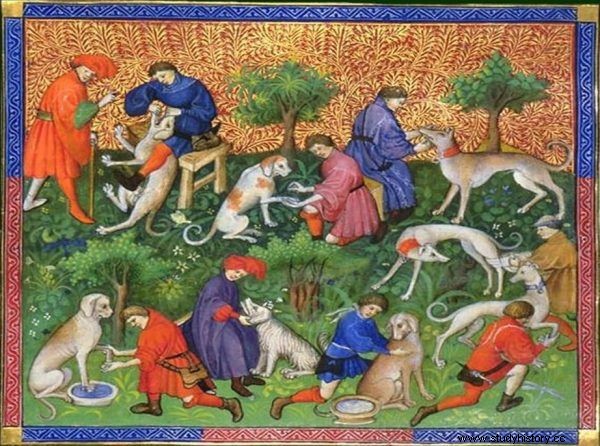
Could this group include another candidate for a saint who would protect the child with his own body? An illustration from "Livre de chasse" by Count Gaston Febus at the end of the 14th century (source:public domain).
The faithful doggie rushed to attack, staining the blood of the reptile in combat. Upon their return, the parents found Guinefort with his mouth covered in blood. Thinking it was the blood of a baby, the master of the house killed the dog. However, when the household found the whole and safe child and the dead snake, everything became clear. The dog was declared a martyr. In the 12th century, Guinefort was venerated as the protector of children.
One hundred years later, the Holy Inquisition tried to eradicate this cult, but it was practiced even before the Second World War. People prayed through Guinefort's intercession and brought children's clothes to the vicinity of his grave (read more on this topic) .
9. A bear helpful in a pick-up
The story of Baśka Murmańska began with the fact that two soldiers - a Pole and an Italian - at a ball in Arkhangelsk noticed the same lady. Gentlemen, to impress their chosen one, they brought wonderful creatures to her window. The Italian brought a blue fox with a beautiful and delicate fur and a lush kit. The Pole brought a real white bear.
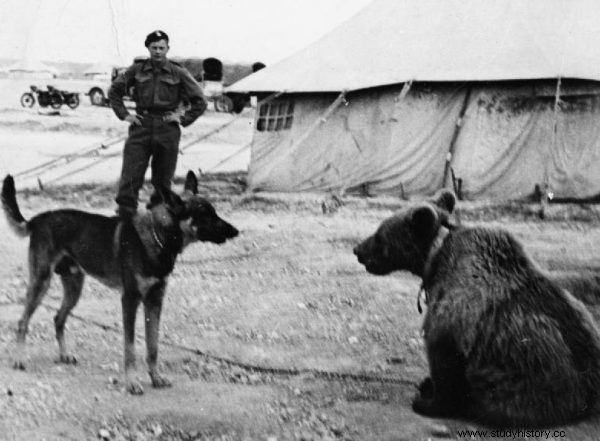
Bears' contacts with smaller animals usually looked interesting… especially to outside observers. This time Wojtek the bear gets to know the dog (source:public domain).
At the sight of his enemy, the fox deserted, knocking over the Italian. The Pole, Ensign Walenty Karaś, triumphed. His shaggy pet is none other than BaĘka. The female soldier was admitted to the battleground of Murmansk under the command of Col. Julian Skokowski. BaĘka was even assigned a bear.
Niedźwiedzica came to the Vistula River one day with Poles. She was stationed with them in Gdańsk and Modlin. When the Murmanians paraded in 1919 on Saski Square, Baśka could not be missing. She was honored to shake Marshal Piłsudski's hand (read more on this topic) .
8. A horse that became a corporal
The horse Grom began his career in one of the worst roles - he was in carts pulling cannons on the battlefield. In the years 1918-1920 he served in the heaviest battles. During one of the clashes, the horse even achieved its charge. When almost all of the animals in his harness were killed, he and one train car pulled the endangered cannon out from under the fire.

The fate of the horse in the army was not easy ... but a brave steed could count on honors and eternal gratitude. The photo shows the preparation of Legionnaires' horses for loading onto the Echelon (source:public domain).
Though he could never be officially promoted to a military rank, the rank of corporal was given to him by the soldiers themselves. The cavalrymen made sure that the younger, fresh age groups respected this charge won in battle. Recruits were required to salute the horse by passing in the stables near his stall .
Grom was not only brave but also very wise. Throughout the years of service in the military, he learned commands better than many cavalrymen. He carried out all commands without hesitation. He did not make a mistake in his pace, and on the occasion of important ceremonies he gave a show of his seriousness. The horse walked proudly, with its head straight, as if it realized it was representing a regiment (read more on that) .
7. An ambulance mule
In the winter of 1944, heavy rains turned Italy's roads into quagmire. Under such conditions, allied tracked vehicles became completely useless. Only ... mules came to rescue the troops. Smarter than horses and less wayward than donkeys, they also had little nutritional requirements. They were tough and they did great on winding mountain paths.
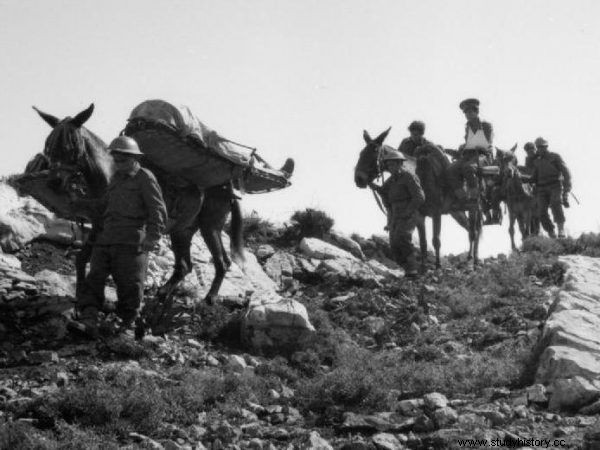
The British Medical Service during the Second World War stood mules in the mountainous areas. Photo from the Imperial War Museums archive (source:public domain).
Caravans of mules constantly traversed the narrow tracks, carrying ammunition and provisions to the front and taking away the wounded and dead. Many animals were killed or injured. It's hard to imagine how gruesome the night caravans looked like. Some of the wounded died when the mules lost their balance.
Under such conditions, a specific bond was developed between humans and animals. One British soldier mentioned that herdsmen treated their mules like dogs or cats. At the sight of the injured and killed animals, their keepers became utterly hysterical (read more on this topic) .
This article has more than one page. Please select another one below to continue reading.Attention! You are not on the first page of the article. If you want to read from the beginning click here.
6. The lion among the marines
Iwo Jima Lions are American soldiers who took part in the bloodiest campaign in the Far East during World War II. The true elite of the Marines, the 28th Regiment Battlegroup of the US Marine Corps, had its mascot. The soldiers took a small… lion cub into their ranks.

The lion is impressive not only in art and mythology, but also in war. The painting "Una and the Lion" by Briton Rivière (source:public domain).
The pet was purchased by Private Bob Coster for $ 25 from the Los Angeles Zoo. It was supposed to be a gift for his son. The private's wife flatly refused. Coster therefore gave him to the military. The little lion, named Roscoe, ended up in the marines while they were still stationed in the United States. Later, the soldiers managed to obtain permission from the command to take their mascot to Hawaii, where they were rebased.
The lion cub took an active part in the daily life of the regiment. As a mascot, it participated, for example, in parades, to the surprise and amusement of the observers. It often happened that Roscoe rode on the hood of a jeep accompanied by several "lion tamers" who were designed to calm the pet (read more on this topic) .
5. A very mischievous Wojtek
Wojtek - the mascot of the 2nd Polish Corps - is probably the most famous bear in our country. The Iranian shepherd sold him to Polish soldiers as a little bear for a few loot, some local currency and a large can of canned meat .
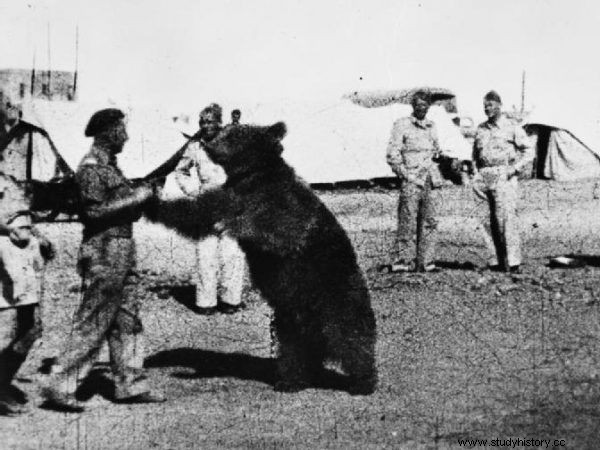
Wojtek's favorite sport was wrestling with Polish soldiers (source:public domain).
Wojtek liked to eat well. In order to have something to feed him, he was enlisted in the state of the 22nd Transport Company. For the love of food, a bear once had to wreck a food warehouse while drunk. Another time, devoured the entire contents of the can with a supply of… shoe polish.
Wojtek also turned out to be a lover of women's underwear. Once he tore a rope with women's underwear. The teddy bear's keepers returned the loot to their rightful owners. Soon after, the women visited with the furry bandit. During this visit, Wojtek personally apologized to the victims, covering his bear with his huge front paws and wailing mournfully. The girls were charmed by him (read more about it) .
4. Seagulls-bombers
The British conducted pioneering experiments in the field of using animals for the location of submarines. Sea lions and gulls were trained in strict secrecy. The former were trained to ignore the presence of fish, but respond to the sound of the submerged U-boat.
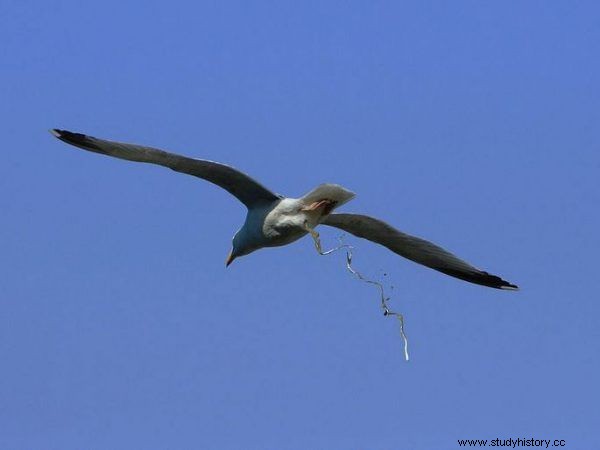
Seagull droppings used as an effective weapon against U-boats? The British really did consider this possibility! (photo:Sanchezn; license CC BY-SA 3.0).
Works on the use of gulls were much more advanced. The task of these birds was to "bomb" the periscope with their own droppings so as to blind the German crew! The Royal Navy took the matter as seriously as possible and even assigned its own submarine to conduct trials. The project was finally suspended in August 1917.
All these ideas have not been put to practical use. The most effective way to destroy the U-boat was by firing it or being rammed by a surface ship (read more about it) .
3. A drunken elephant in an ancient army
Ancient elephants were deliberately drunk for at least several reasons. The fact is that they are skittish animals, which was often felt in war. For example, in the Battle of Zama, Carthaginian elephants, instead of trampling the legionnaires, fell between the gaps formed in the Roman ranks.
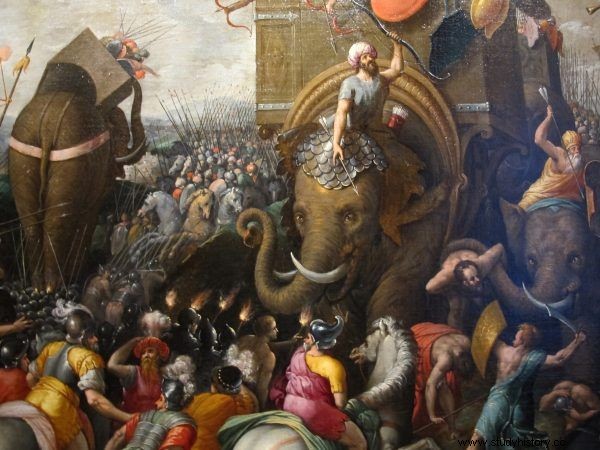
A drunk elephant is a happy elephant. More or less. A picture of the Battle of Zama from the end of the 16th century (photo:Sailko, license CC BY-SA 3.0).
Seeing several possibilities, the animals chose the easiest and least risky path. Moreover, some of the elephants panicked before they even charged . Alcohol was the panacea for this ailment. After him, the elephants became more angry, less timid, and less sensitive to the wounds of javelins.
Drunken elephants were also used outside the battlefield to make them ruthless executioners. Pharaoh Ptolemy VIII decided to force drunk elephants to crush the captured Jews . However, enraged and confused animals rushed to the king's friends awaiting the bloody spectacle, murdering many of them (read more on this topic) .
This article has more than one page. Please select another one below to continue reading.Attention! You are not on the first page of the article. If you want to read from the beginning click here.
2. A dog that really had a nose for ambushes
The shepherd dog in plain clothes was named Brian and was put into the army by a six-year-old owner. He joined the army as a result of an experimental inclusion in the ranks of specially trained amphibious dogs. They were supposed to jump with a parachute under enemy fire, together with people. Training the dog on duty called Bing began with getting used to the noise and learning to recognize the smells of explosives.
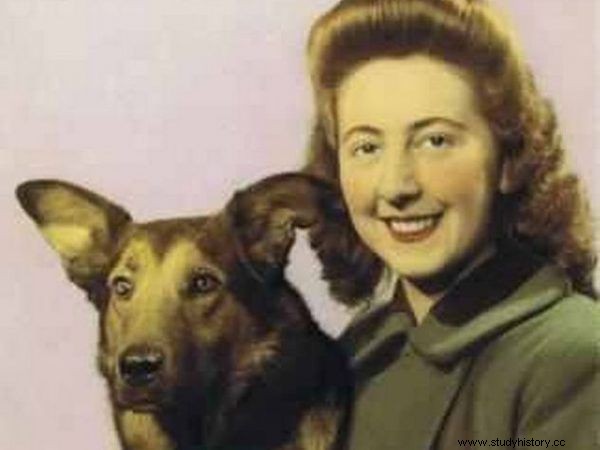
Bing and his cruel owner… after the war.
After two months the jumps started. If any of the quadrupeds had problems with motivation to leave the aircraft, they did not get stuck. The military boot saved the situation and the dog immediately regained courage. Even the heroic Bing needed such help at least once in his career.
Bing was a tough and well-trained soldier. During D-Day, he parachuted under heavy fire into hostile territory. During each rest, he was on guard, watching over the sleepers. During one of the missions, the brave dog saved his comrades-in-arms from an ambush when the enemy lurked in one of the houses. German soldiers were surrounded and taken prisoner and Bing became a hero (read more about it) .
1. The hen that flew
Among the clack breed was one red hen named Myrtle, which belonged to Lieutenant Pat Glover of the 4th Parachute Brigade of the 1st British Airborne Division. The brave hen with her master underwent parachute training and made six training jumps.

Myrtle definitely stood out above her breed, denying the idea that chickens are flightless birds. Painting by Carl Jurtz from 1899 (source:public domain).
At first she was the distance to the ground between her and the lieutenant resting safely in Glover's canvas bag. On subsequent flights, covered greater and greater distances on her own, waving her wings furiously. Finally, she flew over 100 meters on her own, then patiently waited on the ground for her master.
Kurka was a full member of the 4th Parachute Brigade and proudly wore paratroopers' wings around her neck. When the British landed at Arnhem, Myrtle was in her master's backpack. The Germans greeted the paratroopers with a sharp greeting. Many soldiers died then, including the brave hen. She was buried by the British with the paratrooper badge awarded to her (read more about it) .
